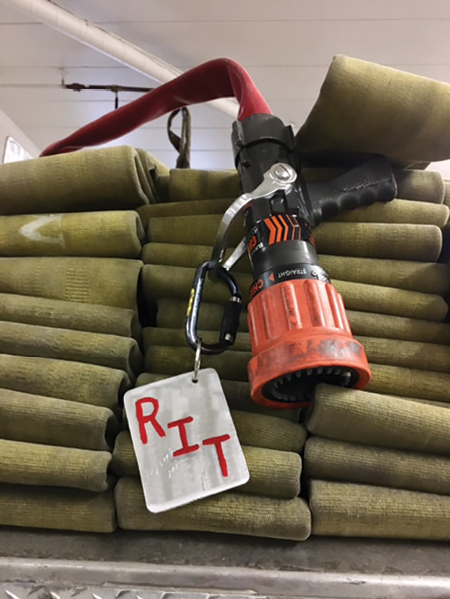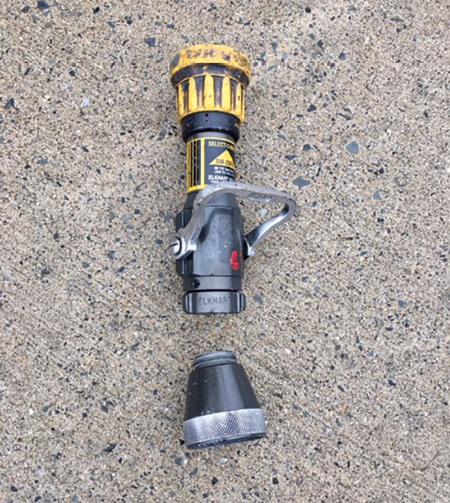By PAUL LaROCHELLE JR.
Scenario: Your company is dispatched as the rapid intervention team (RIT) for a working fire on the north end of town. The fire is in a 2½-story wood-frame dwelling built in the 1920s. The crew uses its size-up information to determine that the home is of balloon-frame construction; fire can be throughout this building in a moment’s notice. The main body of fire is in the basement with some extension to the upper floors, and multiple crews are operating in the building using several attack lines.
As the RIT leader, you instruct your three-person crew to assemble the equipment, which consists of a stokes basket, a RIT pack, a search rope, a thermal imaging camera with a spare battery, a gas-powered saw, a set of irons, portable radios, and an extra flashlight. You contact the incident commander (IC) to obtain an incident status report while instructing a member to conduct a 360° survey of the building. The member returns from his 360° survey and reports the need for additional ladders around the building. Being a proactive officer, you relay this information to the IC, who addresses it quickly.
Suddenly, your worst fear happens—a Mayday is transmitted over the portable radio: “Mayday, Mayday, Mayday. Engine 1 in basement, cut off from the stairs, and we have lost water in our line.” Your RIT springs into action. However, the piece of equipment you need most is not readily available: a hoseline to protect yourself and the trapped firefighters.
The Solutions
The engine closest to the fire building has possibly been stripped of its attack lines or, at the very least, its nozzles. So, where does your hoseline come from now? An engine is down the street that is most likely unattended and without a water supply. There may be a high-rise bundle tucked away in a compartment on the engine in front of the building. A line already in operation may need to be relocated. Time is of the essence. The firefighters in the basement are “behind the eight ball” and need a resolution to their situation now.


(1-2) Photos by author.
During my career, I have been to many fires throughout the country, and I have never seen a RIT designate a handline. A properly charged and positioned hoseline is an essential piece of equipment for the RIT. We take for granted our ability to stretch or reposition a hoseline; we may not be able to reposition a line already in use because of fire conditions in the area. We may have difficulty getting that same hoseline in position initially because of clutter, or perhaps portions of the ceiling and walls may fall onto the operating hoseline during overhaul. However, it must be able to reach all portions of the building, which makes a proper stretch size-up crucial for success.
Multiple scenarios exist where applying water to the fire will improve a bad situation. Imagine if a firefighter goes through the roof and falls partially or fully into an attic. Fire conditions in the attic or cockloft space, which necessitated the need for vertical ventilation, will likely increase because of an influx of air. You may also need the line to enter the attic space or to protect the trapped firefighter from the fire and heat. A firefighter who is partially or fully through the floor and into a basement will most likely need the protection of a hoseline. You can send the line into the hole so that the crew can protect themselves from any fire. You can use this same hoseline to lift a firefighter from a basement or cellar. The use of lightweight construction materials in more intense fires has caused an escalation of early structural failures.
Another scenario may find a search team cut off from the stairs on an upper floor and forced to a window. If the RIT places a ladder near the window, it can escape the area quickly. If the RIT has to wait for a ladder and fire enters the room, a single exterior firefighter can apply water to the area to protect the RIT. In these situations and others, a handline will help protect the Mayday firefighter. The line is not the end-all, be-all for the RIT, but it should be another piece of equipment readily available if one of the above scenarios unfolds.
More Hoseline Options
At this point, you may be thinking, “I have enough gear to get assembled, but now I have to assemble a hose as well?” Redeploying a line already in use is always an option; this may take some time depending on the conditions and stretching distance. Your most useful option is a dry line that has been flaked out in anticipation of being needed, but make sure you have enough resources on scene to accomplish this. Other options include tagging a nozzle bail (photo 1) that is still on the engine to signify whether the line is to be used by the RIT only. Also consider having a nozzle as part of your initial equipment to attach to any hose still on the engine parked in front of the building. You can also use a reducer to hook up the nozzle to a larger-diameter line such as a 2½-inch (if it is being used). One nozzle and one reducer can solve multiple situations (photo 2). In addition. You can use a high-rise pack (if one is kept on that same engine), the location of which must be known in advance of the Mayday. Many RITs are comprised of mutual-aid communities that are unfamiliar with apparatus closest to the fire building.
The proper stretch and deployment of the attack hoseline are important fireground responsibilities. However, when it comes to protecting yourself and your RIT, do not wait until the need for the line arises. Like a search rope, an attack hoseline can act as a pathway to a Mayday firefighter.
The next time your department trains in rapid intervention, see how long it takes to establish an attack line for a Mayday situation. Be realistic; the apparatus closest to the fire building contains hose but without the nozzles connected. You must locate the nozzle and then stretch, break, and charge the line. This drill also serves to sharpen your skills for your next fire.
Proactive—rather than reactive—RIT operations are essential to firefighter safety. This includes the positioning of ground ladders and aerial devices on all sides of the structure, removing hazards (window bars, fortified doors, and so on), and applying water to gain access or protect trapped firefighters. If you feel you do not have enough people assigned to your RIT for these functions, explore increasing your personnel or changing your alarm response.
The “R” in RIT should also stand for “READY.” These crews need to respond to emergencies quickly. However, and perhaps more importantly, the RIT needs to be READY through training to act on any situations that may occur.
PAUL LaROCHELLE JR. is a 40-plus-year fire service veteran who has worked as a volunteer, paid call, and full-time firefighter in rural and suburban settings. He is a 30-year member of and a lieutenant with the Worcester (MA) Fire Department. LaRochelle is an instructor for PL Vulcan Fire Traini g Concepts and the Massachusetts Fire Academy as well as the inventor of the FEDS forcible entry door.

